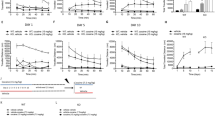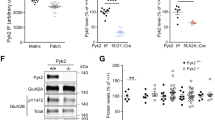Abstract
We sought to determine the role of functionally selective dopamine (DA) signalling pathways (G protein or β-arrestin) in DA-dependent behaviours. Mice that were globally deficient for β-arrestins or mice deficient in GSK3β in D2 receptor (D2R)-expressing neurons were used to investigate the role of functional selectivity in DA-dependent behaviours such as locomotor activity and conditioned place preference (CPP). Wild-type or knockout mice were injected with drugs such as morphine and amphetamine, which are known to increase DA levels in the brain and to induce a hyper-locomotor response and CPP. Unlike β-arrestin1 (βarr1)-deficient mice, mice globally deficient for β-arrestin2 (βarr2) mount a reduced hyperlocomotor response to either morphine or amphetamine. However, mice deficient in GSK3β in D2R-expressing neurons show a significantly reduced locomotor response to only amphetamine but not morphine. Interestingly, all mice tested show a normal CPP response to either morphine or amphetamine. β-arrestin-mediated DA receptor signalling has an important role in the locomotor response, but not CPP, to drugs such as morphine and amphetamine, demonstrating a functional selectivity of DA-dependent behaviours in mice. It is likely that G-protein-dependent signalling through DA receptors mediates the CPP response.
This is a preview of subscription content, access via your institution
Access options
Subscribe to this journal
We are sorry, but there is no personal subscription option available for your country.
Buy this article
- Purchase on Springer Link
- Instant access to full article PDF
Prices may be subject to local taxes which are calculated during checkout



Similar content being viewed by others
References
Missale C, Nash SR, Robinson SW, Jaber M, Caron MG . Dopamine receptors: from structure to function. Physiol Rev 1998; 78: 189–225.
Lefkowitz RJ, Shenoy SK . Transduction of receptor signals by beta-arrestins. Science 2005; 308: 512–517.
Ferguson SS, Downey III WE, Colapietro AM, Barak LS, Ménard L, Caron MG . Role of beta-arrestin in mediating agonist-promoted G protein-coupled receptor internalization. Science 1996; 271: 363–366.
DeWire SM, Ahn S, Lefkowitz RJ, Shenoy SK . Beta-arrestins and cell signaling. Annu Rev Physiol 2007; 69: 483–510.
Urban JD, Clarke WP, von Zastrow M, Nichols DE, Kobilka B, Weinstein H et al. Functional selectivity and classical concepts of quantitative pharmacology. J Pharmacol Exp Ther 2007; 320: 1–13.
Rajagopal S, Kim J, Ahn S, Craig S, Lam CM, Gerard NP et al. Beta-arrestin- but not G protein-mediated signaling by the ‘decoy’ receptor CXCR7. Proc Natl Acad Sci USA 2010; 107: 628–632.
Richman JG, Kanemitsu-Parks M, Gaidarov I, Cameron JS, Griffin P, Zheng H et al. Nicotinic acid receptor agonists differentially activate downstream effectors. J Biol Chem 2007; 282: 18028–18036.
Walters RW, Shukla AK, Kovacs JJ, Violin JD, DeWire SM, Lam CM et al. Beta-Arrestin1 mediates nicotinic acid-induced flushing, but not its antilipolytic effect, in mice. J Clin Invest 2009; 119: 1312–1321.
Svenningsson P, Lindskog M, Rognoni F, Fredholm BB, Greengard P, Fisone G . Activation of adenosine A2A and dopamine D1 receptors stimulates cyclic AMP-dependent phosphorylation of DARPP-32 in distinct populations of striatal projection neurons. Neuroscience 1998; 84: 223–228.
Bateup HS, Svenningsson P, Kuroiwa M, Gong S, Nishi A, Heintz N et al. Cell type-specific regulation of DARPP-32 phosphorylation by psychostimulant and antipsychotic drugs. Nat Neurosci 2008; 11: 932–939.
Greengard P . The neurobiology of slow synaptic transmission. Science 2001; 294: 1024–1030.
Beaulieu JM, Sotnikova TD, Marion S, Lefkowitz RJ, Gainetdinov RR, Caron MG . An Akt/beta-arrestin 2/PP2A signaling complex mediates dopaminergic neurotransmission and behavior. Cell 2005; 122: 261–273.
Beaulieu JM, Tirotta E, Sotnikova TD, Masri B, Salahpour A, Gainetdinov RR et al. Regulation of Akt signaling by D2 and D3 dopamine receptors in vivo. J Neurosci 2007; 27: 881–885.
Urs NM, Daigle TL, Caron MG . A dopamine D1 receptor-dependent beta-Arrestin signaling complex potentially regulates morphine-induced psychomotor activation but not reward in mice. Neuropsychopharmacology 2011; 36: 551–558.
Patel S, Doble BW, MacAulay K, Sinclair EM, Drucker DJ, Woodgett JR . Tissue-specific role of glycogen synthase kinase 3beta in glucose homeostasis and insulin action. Mol Cell Biol 2008; 28: 6314–6328.
Srinivas S, Watanabe T, Lin CS, William CM, Tanabe Y, Jessell TM et al. Cre reporter strains produced by targeted insertion of EYFP and ECFP into the ROSA26 locus. BMC Dev Biol 2001; 1: 4.
Urs NM, Snyder JC, Jacobsen JP, Peterson SM, Caron MG . Deletion of GSK3beta in D2R-expressing neurons reveals distinct roles for beta-arrestin signaling in antipsychotic and lithium action. Proc Natl Acad Sci USA 2012; 109: 20732–20737.
Bohn LM, Lefkowitz RJ, Gainetdinov RR, Peppel K, Caron MG, Lin FT . Enhanced morphine analgesia in mice lacking beta-arrestin 2. Science 1999; 286: 2495–2498.
Conner DA, Mathier MA, Mortensen RM, Christe M, Vatner SF, Seidman CE et al. beta-Arrestin1 knockout mice appear normal but demonstrate altered cardiac responses to beta-adrenergic stimulation. Circ Res 1997; 81: 1021–1026.
Bohn LM, Gainetdinov RR, Sotnikova TD, Medvedev IO, Lefkowitz RJ, Dykstra LA et al. Enhanced rewarding properties of morphine, but not cocaine, in beta(arrestin)-2 knock-out mice. J Neurosci 2003; 23: 10265–10273.
Di Chiara G, Imperato A . Drugs abused by humans preferentially increase synaptic dopamine concentrations in the mesolimbic system of freely moving rats. Proc Natl Acad Sci USA 1988; 85: 5274–5278.
Beaulieu JM, Gainetdinov RR, Caron MG . Akt/GSK3 signaling in the action of psychotropic drugs. Annu Rev Pharmacol Toxicol 2009; 49: 327–347.
Smith JW, Fetsko LA, Xu R, Wang Y . Dopamine D2L receptor knockout mice display deficits in positive and negative reinforcing properties of morphine and in avoidance learning. Neuroscience 2002; 113: 755–765.
Svenningsson P, Tzavara ET, Carruthers R, Rachleff I, Wattler S, Nehls M et al. Diverse psychotomimetics act through a common signaling pathway. Science 2003; 302: 1412–1415.
Beaulieu JM, Sotnikova TD, Gainetdinov RR, Caron MG . Paradoxical striatal cellular signaling responses to psychostimulants in hyperactive mice. J Biol Chem 2006; 281: 32072–32080.
Allen JA, Yost JM, Setola V, Chen X, Sassano MF, Chen M et al. Discovery of beta-arrestin-biased dopamine D2 ligands for probing signal transduction pathways essential for antipsychotic efficacy. Proc Natl Acad Sci USA 2011; 108: 18488–18493.
Acknowledgements
This work was supported by the National Institutes of Health grants RO1-MH-073853 and U-19-MH-082441. The authors thank Wendy Roberts, Xiuqin Zhang and Benjamin Phillips for maintenance of the mouse colony. GSK3β floxed mice were generously provided by Dr James Woodgett at the Samuel Lunenfeld Research Institute, Toronto, Canada.
Author information
Authors and Affiliations
Corresponding author
Ethics declarations
Competing interests
MGC has received consulting fees from Lundbeck A/G, owns equity in in USD Acadia Pharmaceutical and has received grant support from Hoffmann LaRoche. NMU has declared no conflicts of interest.
Additional information
This article is published as part of a supplement sponsored by the Université Laval's Research Chair in Obesity in an effort to inform the public on the causes, consequences, treatments, and prevention of obesity.
Rights and permissions
About this article
Cite this article
Urs, N., Caron, M. The physiological relevance of functional selectivity in dopamine signalling. Int J Obes Supp 4 (Suppl 1), S5–S8 (2014). https://doi.org/10.1038/ijosup.2014.3
Published:
Issue Date:
DOI: https://doi.org/10.1038/ijosup.2014.3
Keywords
This article is cited by
-
Opioid-like adverse effects of tianeptine in male rats and mice
Psychopharmacology (2022)
-
Targeting β-Arrestins in the Treatment of Psychiatric and Neurological Disorders
CNS Drugs (2021)



